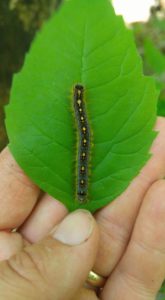Forest tent catepillars have arrived – they will stay for a 3 year cycle – the hope is they move through the forest and don’t stay in one area. They cause damage to a Maple and other trees by eating the foliage during growing season.
The forest tent caterpillar (Malacosoma disstria Hubner) may be found throughout the United States and Canada wherever hardwoods grow. Their favored host are sugar maple and poplar ( also known as aspen) Regionwide outbreaks have occurred at intervals varying from 6 to 16 years in northern areas. I posted a video on our Facebook page that shows the significant leaf reduction that occurred in our sugarbush this spring. The forest tent catepillar is a native insect that has attracted attention since colonial times. What I am learning and trying to focus on is the fact that these are native insects and while in the short term (sometimes long term due to death of a tree) is that we should just leave nature alone. Yes the catepillars do damage but sometimes you have to look at the bigger picture.

Forest Tent Catepillar
Catepillars came and ate the leaves. The leaves grew back but with a smaller leaf which created a thinner tree canopy. We have had 2 very wet years followed by a dry year. This year the foliage looks very dull and brown – even the conifers. That brown is caused by the excessive amount of seeds that the trees are bearing this year. Those seeds have and will be dropping to the forest floor to regenerate. Back to the catepillars that ate the leaves – less leaves equals more sunlight reaching through the canopy. More light helps theses seedlings establish which long term starts a whole new generation of new trees.
We do not expect to see a reduction in maple syrup production due to forest tent catepillars. I mentioned before that they can cause the death of a tree but usually that tree already has damage of some sort and does not deal well with any added stress. Tapping maple trees does add stress to the tree but we do not overtap (using too many taps per tree) or tap trees that are too small in diameter (a minimum of 12 inches). We also use what is called a health spout which has a smaller entry point for the tree.

